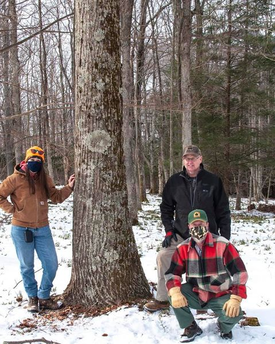|
From Amy Metheny at WVU:  We have a new state champion! A few weeks ago, I travelled to private property to conclusively identify a suspected American chestnut. I got confirmation this morning that it is in fact the largest living American in West Virginia! This tree has beautiful timber form and bark that looks so much like a Northern red oak that I almost passed it. It also has beautiful orange, hairless twigs with orange buds unlike Chinese chestnut which has yellowish to green twigs and buds with lots of tiny hairs. The leaves on this American also have a "crashing wave" shape to the serrations and long, slender, papery, hairless leaves as opposed to the wide, pointier, more squat hairy leaves of its Chinese counterpart. As most of you know, the American chestnut was decimated by a fungal disease known as chestnut blight in the early to mid-1900s. Once growing to be 120 feet tall and up to 13 feet in diameter, according to Gifford Pinchot, finding finding tree over 25 feet now is a rarity, so you can imagine my excitement upon seeing this 80-ft monster. Luckily, this tree exhibited no signs of blight. We suspect this to be an "escape" tree, which means it likely doesn't have any blight resistance, but rather has been lucky to live far enough away from other chestnuts to have escaped infection. As a forest pathology research assistant at WVU, and someone who has worked on chestnut blight for a long time, I belong to and work closely with The American Chestnut Foundation. I'm even the reigning WV Chapter Mrs. Chestnut! TACF is aware of this tree and we will likely be collecting pollen and scion for their breeding programs this year. The landowner is incredibly generous and has kindly offered the material and his help. Comments are closed.
|
Archives
July 2024
Categories |
 RSS Feed
RSS Feed